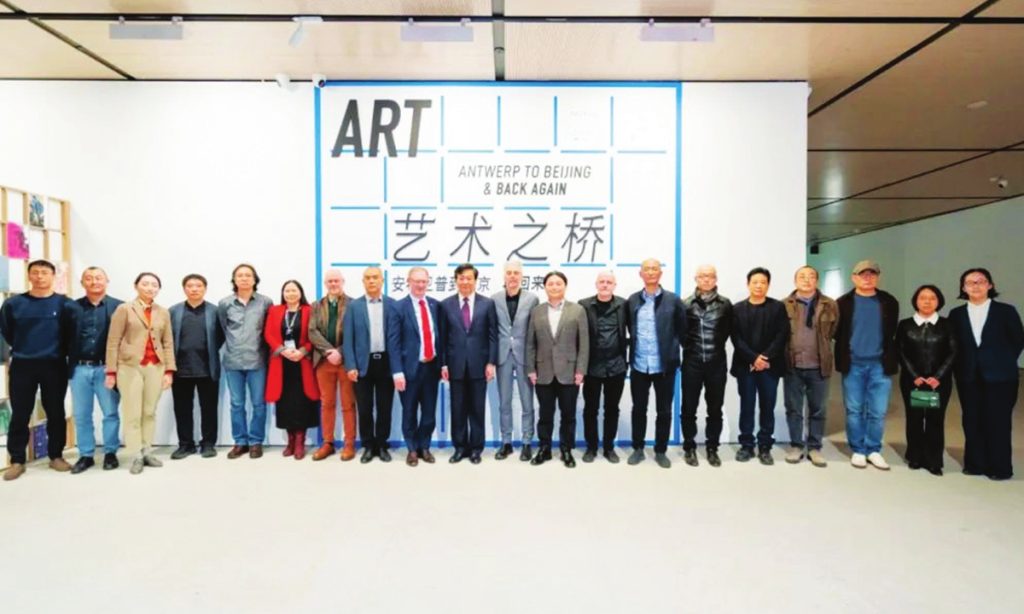GT investigates: How do some US politicians play ‘national security’ card, defame Chinese investment with ‘land grabbing’ fallacy?

Editor's Note:
"Cognitive Warfare" has become a new form of confrontation between states, and a new security threat. With new technological means, it sets agendas and spreads disinformation, to change people's perceptions and thus alter their self-identity. Launching cognitive warfare against China is an important means for Western anti-China forces to attack and discredit the country.
Some politicians and media outlets have publicly smeared China's image by propagating false narratives in an attempt to incite and provoke dissatisfaction with China among people in certain countries. These means all serve the seemingly peaceful evolution of the US strategy to contain China's rise and maintain its hegemony. The Global Times is publishing a series of articles to reveal the intrigues of the US-led West's China-targeted cognitive warfare, and expose its lies and vicious intentions.
In the 10th installment in the series, the Global Times looks into how some US politicians attempt to demonize and drive away Chinese investment from the country, with the recent "land grabbing" fallacy.
A few conspiracy theorists and "persecution mania sufferers" in the US have always imagined that China has launched "battles" against the US in various forms. And now they've created a new narrative: China grabs US land.
In January, Iowa's Governor Kim Reynolds claimed that "China continues to grow more aggressive, and buying American land has been one of the many ways they have waged this new battle." She said she intends to introduce a new law that would strengthen farmland ownership reporting rules in this state.
"…as China's threat adapts, our laws should too," said Reynolds, who was reportedly once very welcoming of Chinese investment. "Let's make sure that American soil remains in American hands," she said.
More states across the US have actively joined in the chorus to support this "land grabbing" fallacy. Data shows that at least 24 states specifically forbid or limit foreign ownership of private farmland. Many of the bans, which target certain countries including China, were introduced in the last two years in the name of "national security," the Global Times found.
Although it is unsurprising to see some US politicians play the anti-China card however they can in an election year, the remark that China, which legally holds only less than 1 percent of all the foreign-owned land in the US, "grabs US land," is still fairly absurd, said some Chinese economists and international relations experts.
How did the states use legislation and public pressure to vilify Chinese investors, and even drive them away from US farmlands? How did the fallacy of "China grabbing US land" come into being? What underhanded tactics have been employed by some US politicians to propel this fallacy? The Global Times tries to uncover what's behind this new round of cognitive war against China.
Virulent laws and actions
Chinese entities held 349,442 acres of agricultural and non-agricultural land in the US, slightly less than 1 percent of its foreign-held acres, or 0.03 percent of the total, according to a report released by the US Department of Agriculture in December 2022. The percentage fell far behind Canada (12.8 million acres), the Cayman Islands (672,000 acres), said a Forbes article in March 2023, listed under "surprising fact."
This negligible percentage nonetheless can't stop politicians in some states from hyping the "China grabbing land" panic and turning it into vitriolic laws and actions.
Arkansas, for instance, in October 2023, ordered agriculture company Syngenta to sell its 160 acres of farmland in this state, only "because the company is Chinese-owned," CNN reported on October 18.
Arkansas passed a state law earlier that year to prohibit certain foreign parties from acquiring or holding land. China is among the prohibited "parties," because it is subject to US arms export controls known as the International Traffic in Arms Regulations (ITAR), said Arkansas Attorney General Tim Griffin.
Regardless of the little connection between arms export control and farmland, Arkansas' order to Syngenta was its first enforcement under the new law. Before this weird logic was finally turned into a legal order, the company "had owned the site for 35 years," according to Syngenta's spokesperson Saswato Das.
Disappointed Syngenta called the order "a shortsighted action" that will hurt Arkansas farmers. "Our people in Arkansas are Americans led by Americans who care deeply about serving Arkansas farmers," CNN quoted Das as saying.
Another infamous example was Texas, which had even tried to ban its citizens of Chinese ancestry from buying a house in the state.
In January 2023, Texas Governor Greg Abbott said he would sign a proposed bill banning citizens and foreign entities from four countries, including China, Iran, North Korea, and Russia, from purchasing Texas land.
The ridiculous "Senate Bill 147" soon sparked months of outcry across the state. In a Senate committee hearing in March that year, more than 100 people, including Asian American business owners, immigrants, and advocacy groups, heavily criticized the bill, according to local media.
Faced with widespread condemnation, the state lawmakers later revised the bill, softening the language to still allow dual citizenship holders and lawful permanent residents of the US to buy property in Texas.
In the last decade, the number of US states that have codified restrictions on foreign ownership of land has risen from 14 to 24, and new restrictions are being proposed in each legislative session, according to Tory Consulting. "As of January 2024, at least five states have active bills in session to restrict foreign ownership of land," said an article published online in February.
China is a main target of this restriction wave, although as a recent opinion piece in The Economist noted: "Chinese landholdings are both tiny and shrinking."
Then how did the "China grabbing US land" fallacy come about?
According to the US National Agricultural Law Center (NALC), a federally funded source of agricultural and food law research and information, many of the states' laws that restrict foreign ownership of land developed at several "political flashpoints," such as the signing of the Declaration of Independence, and the US' westward expansion in the late 1880s.
The latest ongoing "political flashpoint" starts from 2021, partly due to some incidents involving Chinese entities that raised "national security" concerns, said NALC.
One of the incidents was a Chinese company's "purchase of 300 acres near an Air Force base in North Dakota." It was about a Chinese firm planning to build a corn mill in the state. The plan was put on hold in 2023, as the US Air Force said the proposed mill was close to a local air force base and "presents a significant threat to national security."
The state's governor once celebrated the landing of the project in Grand Forks in late 2021, which would have been the city's largest economic development project in recent history, reported the New York Times (NYT) in February 2023. The corn mill was the sort of job-creating opportunity that cities have long fought over, it said.
When examining the timelines of when many US states introduced land ownership restrictions, the Global Times found an obvious "peak" after the "spy balloon" incident in February 2023. On the pretext of "national security," some federal and state politicians frequently attacked the Chinese owners of US farmland at that time, defaming those who owned land near military bases or facilities as spies or potential spies without any proof.
"National security" is a common trope that the Biden administration employs in suppressing China, said Yu Xiang, a non-resident senior fellow at the Center for International Security and Strategy, Tsinghua University. It has hyped a lot of smears against China in the name of national security, such as the "spy balloon," the "chip risk," and the so-called "Chinese citizens conceal secrets" fallacies, Yu explained.
"National security has been a 'black box' area in competitions between countries," Yu told the Global Times. Unlike the previous dumping and subsidy allegations against Chinese products, which China can clarify with tangible proof, the national security-related attacks are usually difficult to disprove, he said.
Moreover, the self-created suspicions may force the Chinese enterprises involved to try to prove their innocence with great effort, said Gao Lingyun, a research fellow at the Institute of World Economics and Politics, Chinese Academy of Social Sciences. "Even if one eventually dispelled the rumors, its reputation, time, and energy would have been damaged," Gao said.
Snaky calculation of US politicians
Chinese ownership of US land has become "a crime to be desired" by some people in the US under the pretext of national security. As the presidential election approaches, "taking back" land from Chinese purchasers is turning into a theatrical performance by local authorities to make political capital.
"This is about where your loyalties lie," Arkansas Governor Sarah Huckabee Sanders said at a news conference, responding to a query about the state ordering Syngenta to sell its farmland, even at the expense of local farmers and employees.
In some US states with fewer people and more land, the leaving of Chinese companies would bring obvious losses, such as revenue and employment, said Gao. "To drive away Chinese entities from their farmland is tantamount to giving up their strengths," he told the Global Times.
But the economic and job losses seem insignificant to some selfish politicians. In US electoral politics, there is usually a personal calculation behind what politicians do or say, said Yu. Authorities in some states want to drive out Chinese entities from farmland, because they believe it can bring them more personal political gains, such as votes, he explained.
Therefore, in order to still get votes even when there have been (or will be) economic damages, the politicians try hard to demonize China, magnifying the security threat of Chinese ownership of farmland to justify their poor political actions, noted some experts in US studies.
They pointed out that the anti-China trope is a well-tested trump card for some politicians to win attention and support, and their "China grabbing land" allegation is no more than a cliché smear that previously targeted Chinese investment in Africa and other Belt and Road Initiative participating nations.
And now this fallacy has spread back to the US, with a few politicians brainwashing US voters with ridiculous conspiracy theories, such as "the corn mill at your doorstep could be spying on you, or it could harm national security."
No wonder other politicians in the US are frustrated with the endless, irrational focus on land. According to a The Economist article published in January, US Congressman Raja Krishnamoorthi complained that some laws intended to stop any Chinese-origin individuals from buying any land at all drift into "outright racism and xenophobia."
Krishnamoorthi wishes politicians would focus more on improving American competitiveness in general, said the article. "Sadly that is harder than blustering about farmland."






